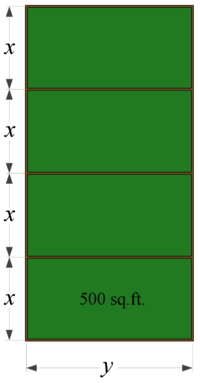Difference between revisions of "009A Sample Final A, Problem 7"
Jump to navigation
Jump to search
m |
m |
||
| Line 21: | Line 21: | ||
!Step 2: | !Step 2: | ||
|- | |- | ||
| − | |'''Form the Equations:''' Notice that we need fencing between each of the pens (think "lion-antelope-lion-antelope" if this isn't clear). We require 2 pieces of length ''x'' for each pen, and a total of 5 pieces of length ''y''. Together, we need a total length of <math style="vertical-align: - | + | |'''Form the Equations:''' Notice that we need fencing between each of the pens (think "lion-antelope-lion-antelope" if this isn't clear). We require 2 pieces of length ''x'' for each pen, and a total of 5 pieces of length ''y''. Together, we need a total length of <math style="vertical-align: -25%;">L = 8x + 5y. </math> |
|- | |- | ||
|On the other hand, we know that each pen has a fixed area of 500 square feet. Thus, we also know that ''xy'' = 500. | |On the other hand, we know that each pen has a fixed area of 500 square feet. Thus, we also know that ''xy'' = 500. | ||
Revision as of 12:03, 24 March 2015
7. A farmer wishes to make 4 identical rectangular pens, each with
500 sq. ft. of area. What dimensions for each pen will use the least
amount of total fencing?
| Foundations: |
|---|
| As a word problem, we must begin by assigning variables in order to construct useful equation(s). As an optimization problem, we will be taking a derivative of one of our equations in order to find an extreme point. |
Solution:
| Step 1: |
|---|
| Declare Variables: We are attempting to find the dimensions of a single pen, such that we use as little fencing as possible for all four pens. Let's use x and y as indicated in the image, and simply call the length of fencing required L. |
| Step 2: |
|---|
| Form the Equations: Notice that we need fencing between each of the pens (think "lion-antelope-lion-antelope" if this isn't clear). We require 2 pieces of length x for each pen, and a total of 5 pieces of length y. Together, we need a total length of |
| On the other hand, we know that each pen has a fixed area of 500 square feet. Thus, we also know that xy = 500. |
| Step 3: |
|---|
| Optimize: Since xy = 500, we also know y = 500/x. Plugging this into our equation for length, we have |
| We now take the derivative to find |
| The denominator can never be zero, and if we set the numerator to zero we find |
| Of course, we can't have negative fencing lengths, so we can ignore the negative root. Finally, we use the area relation to find |
| Thus, the least amount of fencing is used when we size our 500 sq. ft. pens as 20√2 feet by 25/√2 feet. |





